steering BUICK PARK AVENUE 1993 Owners Manual
[x] Cancel search | Manufacturer: BUICK, Model Year: 1993, Model line: PARK AVENUE, Model: BUICK PARK AVENUE 1993Pages: 340, PDF Size: 18.17 MB
Page 38 of 340
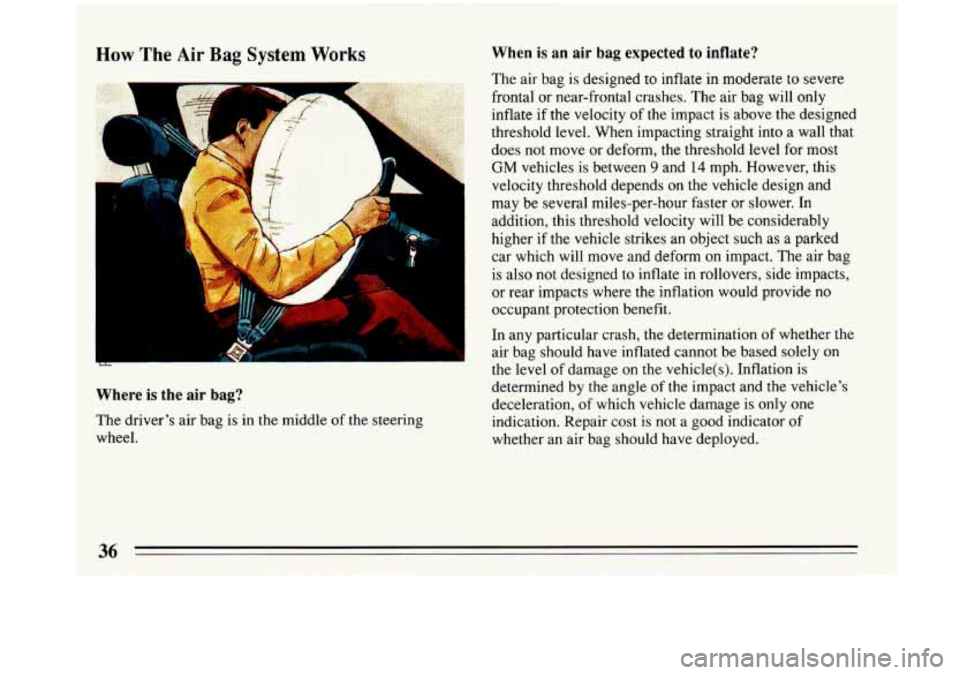
How The Air Bag System Works When is an air bag expected to inflate?
The air bag is designed to inflate in moderate to severe
frontal or near-frontal crashes. The air bag will only
inflate if the velocity
of the impact is above the designed
threshold level. When impacting straight into a wall that
does not move or deform, the threshold level for most
GM vehicles is between 9 and 14 mph. However, this
velocity threshold depends on the vehicle design and
may be several miles-per-hour faster or slower. In
addition, this threshold velocity will be considerably
higher if the vehicle strikes an object such as a parked
car which will move and deform on impact.
The air bag
is also not designed to inflate
in rollovers, side impacts,
or rear impacts where the inflation would provide
no
occupant protection benefit.
In any particular crash, the determination of whether the
, air bag should have inflated cannot be based solely on
the level of damage on the vehicle(s). Inflation is
Where is the air bag?
The driver's air bag is in the middle of the steering
wheel. determined
by the angle of the impact and the vehicle's
deceleration, of which vehicle damage is
only one
indication. Repair cost
is not a good indicator of
whether an air bag should have deployed.
ProCarManuals.com
Page 39 of 340
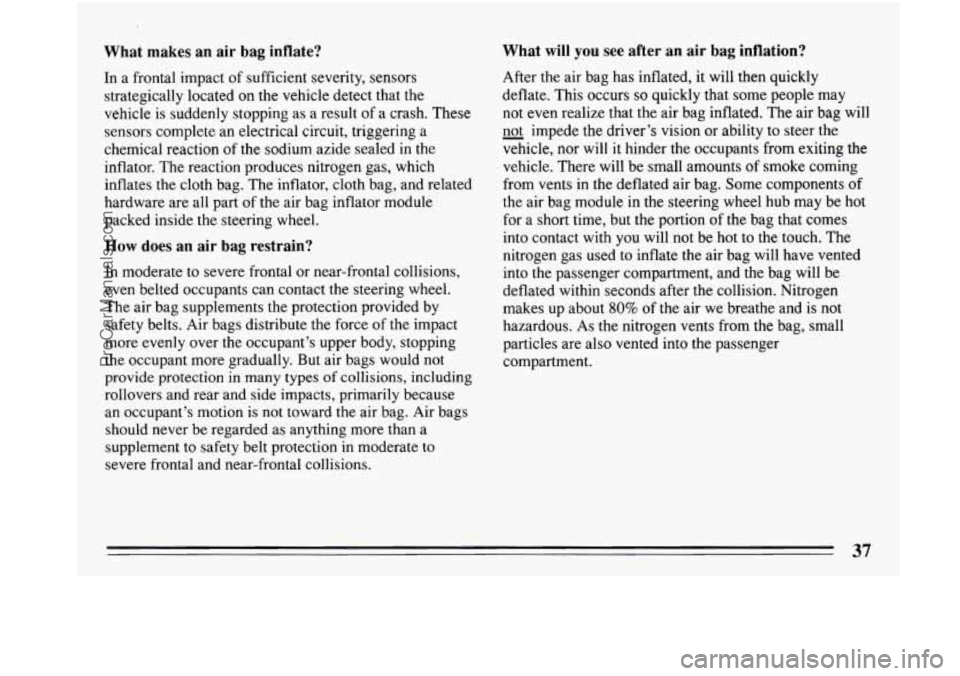
What makes an air bag inflate?
In a frontal impact of sufficient severity, sensors
strategically located
on the vehicle detect that the
vehicle is suddenly stopping as a result
of a crash. These
sensors complete an electrical circuit, triggering a
chemical reaction
of the sodium azide sealed in the
inflator. The reaction produces nitrogen gas, which
inflates the cloth bag. The inflator, cloth bag, and related
hardware are all part of the air bag inflator module
packed inside the steering wheel.
How does an air bag restrain?
In moderate to severe frontal or near-frontal collisions,
even belted occupants can contact the steering wheel.
The air bag supplements the protection provided by
safety belts. Air bags distribute the force
of the impact
more evenly over the occupant’s upper body, stopping
the occupant more gradually. But air bags would not
provide protection in many types
of collisions, including
rollovers and rear and side impacts, primarily because
an occupant’s motion is not toward the air bag. Air bags
should never be regarded as anything more than a
supplement
to safety belt protection in moderate to
severe frontal and near-frontal collisions.
What will you see after an air bag inflation?
After the air bag has inflated, it will then quickly
deflate. This
occurs so quickly that some people may
not even realize that the air bag inflated. The air bag will
- not impede the driver’s vision or ability to steer the
vehicle,
nor will it hinder the occupants from exiting the
vehicle. There will be small amounts
of smoke coming
from vents in the deflated air bag. Some components of
the air bag module in the steering wheel hub may be hot
for
a short time, but the portion of the bag that comes
into contact with you will not be hot to the touch. The
nitrogen gas used to inflate the air bag will have vented
into the passenger compartment, and the bag will be
deflated within seconds after the collision. Nitrogen
,makes up about
80% of the air we breathe and is not
hazardous. As the nitrogen vents from the bag, small
particles are also vented into the passenger
compartment.
37
ProCarManuals.com
Page 40 of 340
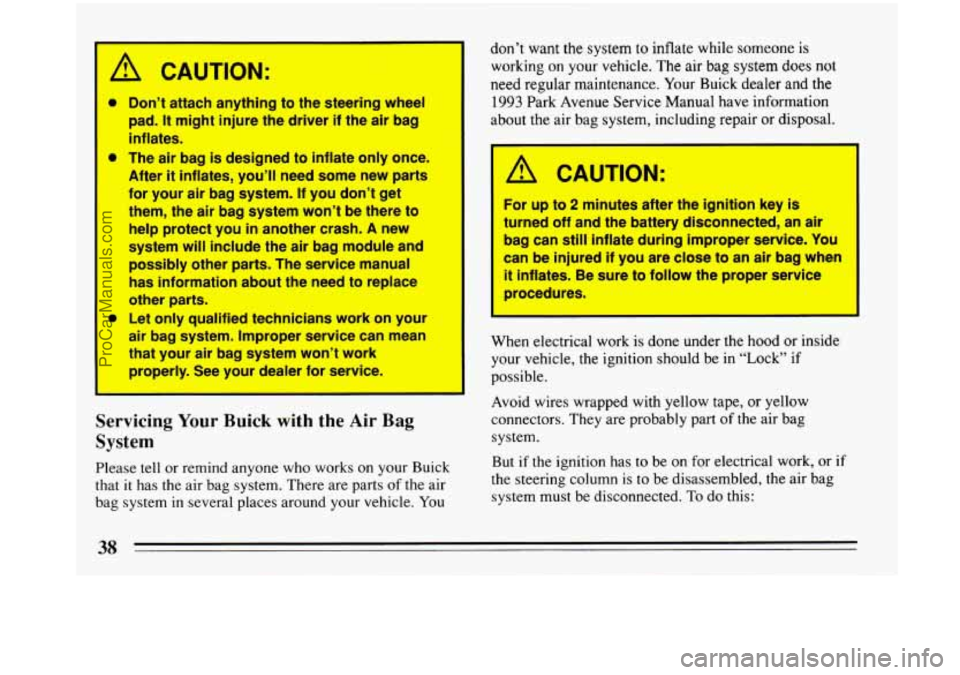
A CAUTION:
a
*
Don’t attach anything to the steering whwl
pad. It might injure the driver if the air bag
inflates.
The
air bag is designed to inflate only once.
After it inflates, you’ll need some new parts
for your air bag system. If you don’t get
them, the air bag system won’t be there to
help protect you in another crash. A new
system will include the air bag module and
possibly other
parts. The service manual
has information
about the need ta replace
other
parts.
Let only qualified technicians work on your
air bag system. Improper service can mean
that your
air bag system won’t work
properly. See your dealer for service.
I- D
Servicing Your Buick with the Air Bag
System
Please tell or remind anyone who works on your Buick
that it has the air bag system. There are parts
of the air
bag system in several places around your vehicle. You don’t want the system
to inflate
while someone is
working
on your vehicle. The air bag system does not
need regular maintenance. Your Buick dealer and the
1993 Park Avenue Service Manual have information
about the air bag system, including repair or disposal.
A CAUTION:
For up to 2 minutes after the ignition key is
turned
off and the battery disconnected, an air
bag can still inflate during improper service. You
can be injured
if you are close to an air bag when
it inflates. Be sure to follow the proper service
procedures.
When electrical work is done under the hood or inside
your vehicle,
the ignition should be in “Lock” if
possible.
Avoid wires wrapped with yellow tape, or yellow
connectors. They are probably part
of the air bag
system.
But if the ignition has to be on for electrical work, or if
the steering column is to be disassembled, the air bag
system must be disconnected.
To do this:
ProCarManuals.com
Page 41 of 340
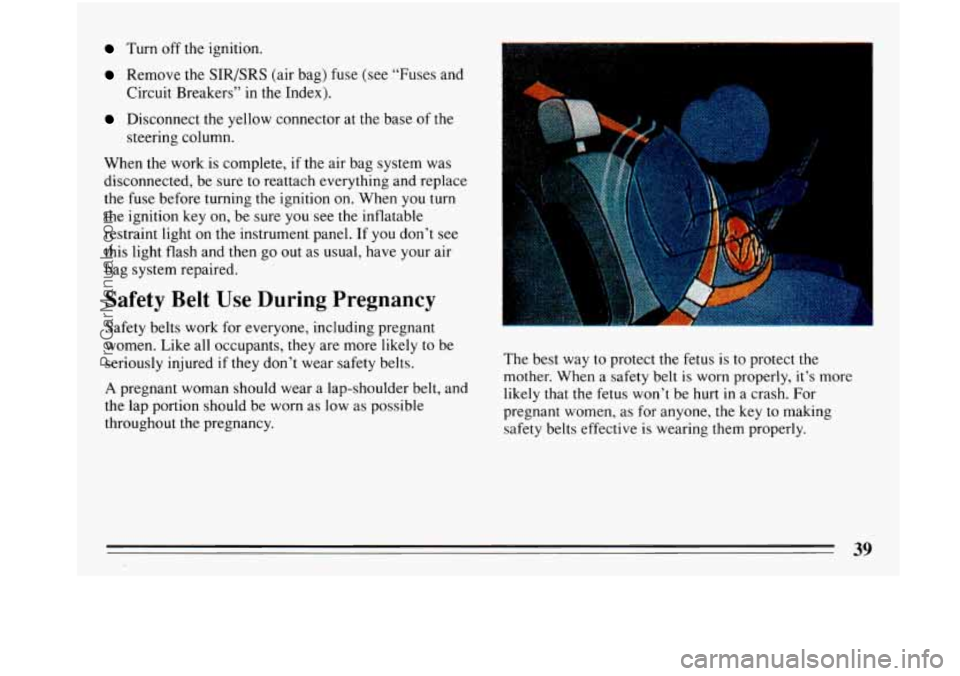
Turn off the ignition.
Remove the SlR/SRS (air bag) fuse (see “Fuses and
Circuit Breakers” in the Index).
Disconnect the yellow connector at the base of the
steering column.
When the work is complete, if the air bag system was
disconnected, be sure to reattach everything and replace
the fuse before turning the ignition on. When you turn
the ignition key on, be sure
you see the inflatable
restraint light
on the instrument panel. If you don’t see
this light flash and then go
out as usual, have your air
bag system repaired.
Safety Belt Use During Pregnancy
Safety belts work for everyone, including pregnant
women. Like all occupants, they are more likely
to be
seriously injured if
they don’t wear safety belts.
A pregnant woman should wear a lap-shoulder belt, and
the lap portion should be worn as low
as possible
throughout the pregnancy. The best way
to protect the fetus is to protect the
mother. When a safety belt
is worn properly, it’s more
likely that the fetus won’t be hurt in a crash. For
pregnant women, as for anyone,
the key to making
safety belts effective is wearing them properly.
ProCarManuals.com
Page 61 of 340

Part 2 Features & Controls
Here you can learn about the many standard and optional features on your Buick. and information on starting. shifting
and braking
. Also explained are the instrument panel and the warning systems that tell you if everything is working
properly
.. and what to do if you have a problem .
Keys ........................................................................\
.... 60
DoorLocks
....................................................................... \
62
NewVehicleBreak-In .............................................................. 74
StartingtheEngine ................................................................. 76
ShiftingtheTransaxle
.............................................................. 80
Windows ........................................................................\
. 90
TiltSteeringWheel
................................................................ 90
Multi-FunctionLever
............................................................... 91
TurnandLaneChangeSignals ................................................... 91
Headlight High-Low Beam Change Signals
......................................... 91
WindshieldWiper/Washer
...................................................... 94
CruiseControl ................................................................ 96
Instrumentpanel
................................................................... 116
Speedometer and Odometer
..................................................... 117
Warning Lights and Gages
...................................................... 117
59
~ .. . ~ .. .. _.__~ ....... - ...... ... ..._- .... -
ProCarManuals.com
Page 67 of 340
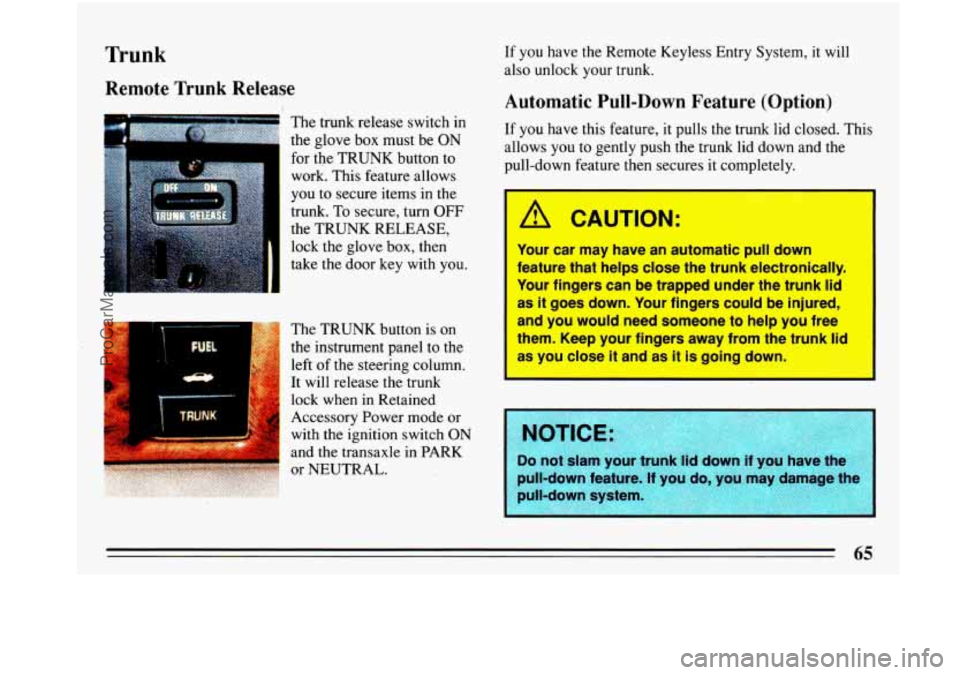
Trunk
Remote Trunk Release
I
The trunk release switch in
the glove
box must be ON
for the TRUNK button to
work. This feature allows
you
to secure items in the
trunk.
To secure, turn OFF
i .= TRUNK
I
the TRUNK RELEASE,
lock the glove box, then
take the door key with you.
The TRUNK button is on
the instrument panel
to the
left of the steering column.
It will release the trunk
lock when in Retained
Accessory Power mode or
with the ignition switch
ON
and the transaxle in PARK
If you have the Remote Keyless Entry System, it will
also unlock your trunk.
Automatic Pull-Down Feature (Option)
If you have this feature, it pulls the trunk lid closed. This
allows you to gently push the trunk lid down and the
pull-down feature then secures it completely.
/d CAUTION:
Your car may have an automatic pull down
feature that helps close the trunk electronically.
Your fingers can be trapped under the trunk lid
as it goes down. Your fingers could be injured,
and you would need someone
to help you free
them. Keep your fingers away from the trunk lid
as you close
it and as it is going down.
NOTICE:
Do not slam your LI UI ~r< lid QuvVn if you have th
pull-down feature. If you do, you may damage t
ProCarManuals.com
Page 73 of 340
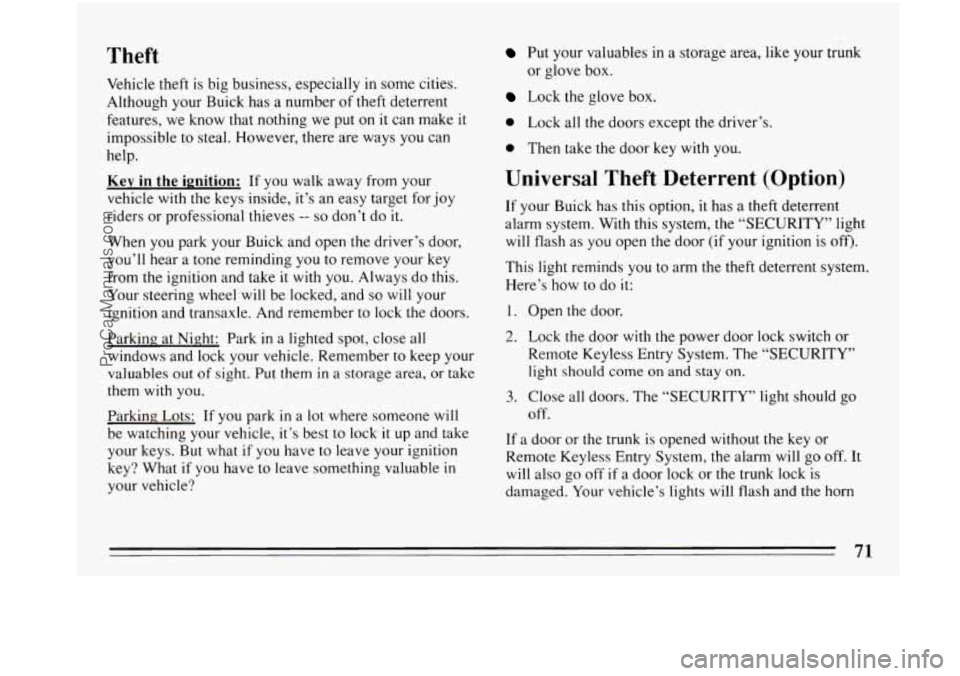
Theft
Vehicle theft is big business, especially in some cities.
Although your Buick has a number of theft deterrent
features, we know that nothing we put on
it can make it
impossible to steal. However, there are ways you can
help.
Kev in the ignition: If you walk away from your
vehicle with the keys inside, it’s an easy target for joy
riders or professional thieves
-- so don’t do it.
When you park your Buick and open the driver’s door,
you’ll hear a tone reminding you to remove your key
from
the ignition and take it with you. Always do this.
Your steering wheel will be locked, and
so will your
ignition and transaxle. And remember to lock the doors.
Parking at Night: Park in a lighted spot, close all
windows and lock your vehicle. Remember
to keep your
valuables
out of sight. Put them in a storage area, or take
them with you.
Parking. Lots: If you park
in a lot where someone will
be watching your vehicle, it’s best to lock
it up and take
your keys. But what if you have
to leave your ignition
key? What if you have to leave something valuable
in
your vehicle?
Put your valuables in a storage area, like your trunk
Lock the glove box.
or glove
box.
0 Lock all the doors except the driver’s.
0 Then take the door key with you.
Universal Theft Deterrent (Option)
If your Buick has this option, it has a theft deterrent
alarm system. With this system, the “SECURITY’’ light
will flash as
you open the door (if your ignition is off).
This light reminds you
to arm the theft deterrent system.
Here’s how to do it:
1. Open the door.
2. Lock the door with the power door lock switch or
Remote Keyless Entry System. The “SECURITY”
light should come on
and stay on.
3. Close all doors. The “SECURITY” light should go
off.
If a door or the trunk is opened without the key or
Remote Keyless Entry System, the alarm will
go off. It
will also
go off if a door lock or the trunk lock is
damaged. Your vehicle’s lights will flash and the horn
71
ProCarManuals.com
Page 77 of 340
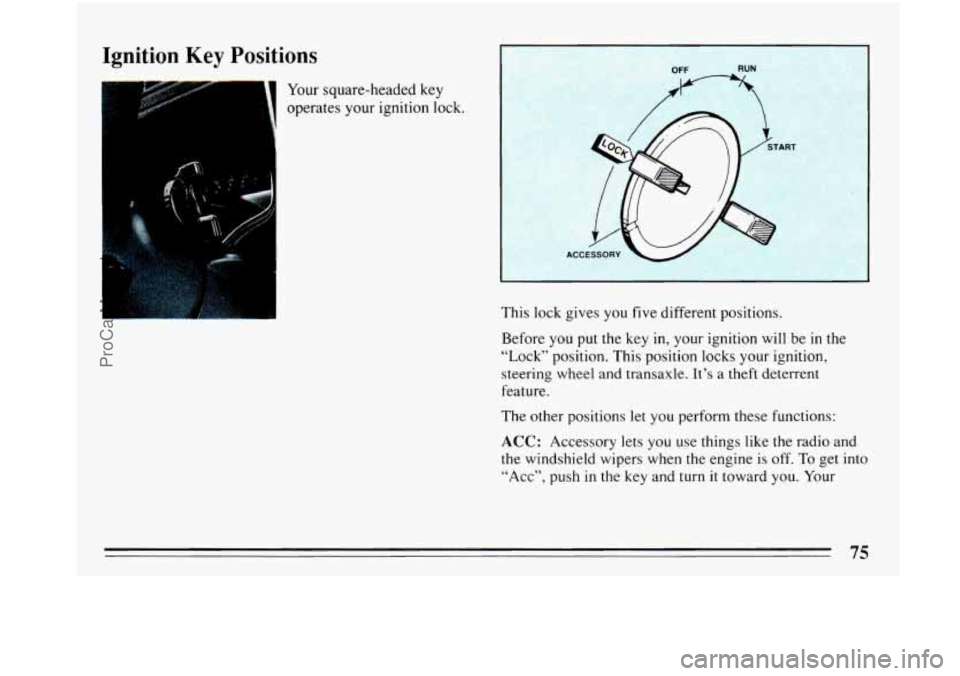
Ignition Key Positions
Your square-headed key
operates your ignition lock.
ACC
1
I
This lock gives you five different positions.
Before
you put the key in, your ignition will be in the
“Lock” position. This position locks your ignition,
steering wheel and transaxle. It’s a
theft deterrent
feature.
The other positions let you perform these functions:
ACC: Accessory lets you use things like the radio and
the windshield wipers when the engine is off. To get into
“Acc”, push in the key and turn it toward
you. Your
ProCarManuals.com
Page 78 of 340
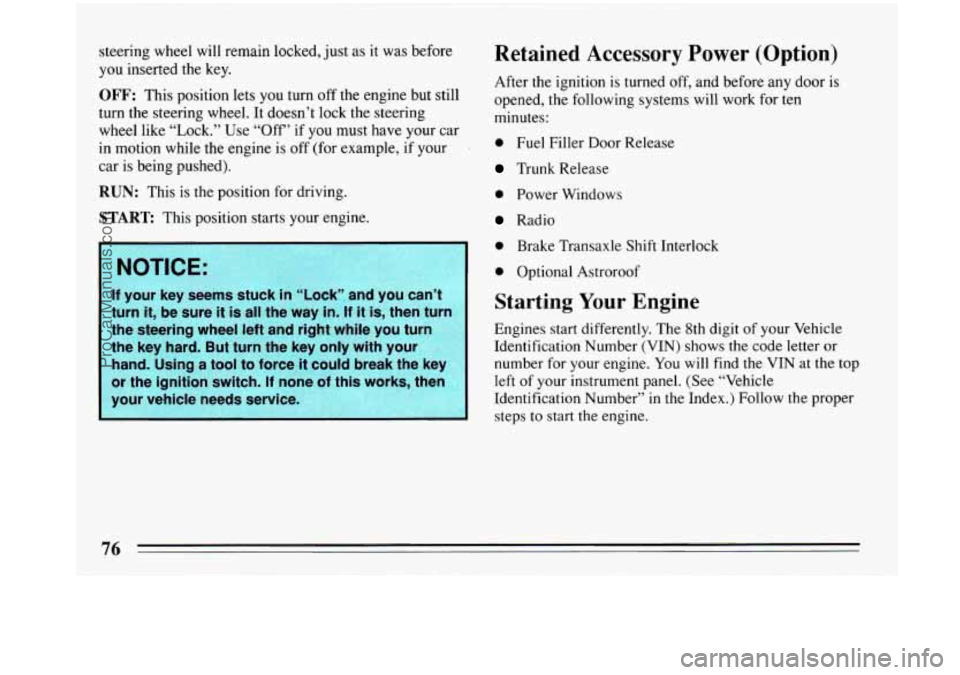
steering wheel will remain locked, just as it was before
you inserted the key.
OFF: This position lets you turn off the engine but still
turn the steering wheel.
It doesn’t lock the steering
wheel like “Lock.” Use “Off’ if
you must have your car
in motion while the engine is off (for example, if your
car is being pushed).
RUN: This is the position for driving.
START This position starts your engine.
NOTICE:
If your key seems stuck in “Lock” and you can’t
turn
it, be sure it is all the way in. If it is, then turn
the steering wheel left and right while you turn
the key hard. But turn the key only with your
hand. Using a tool to force
it could break the key
or the ignition switch. If none of this works, then
your vehicle needs service.
p’
Retained Accessory Power (Option)
After the ignition is turned off, and before any door is
opened, the following systems will work for ten
minutes:
0 Fuel Filler Door Release
Trunk Release
0 Power Windows
Radio
0 Brake Transaxle Shift Interlock
0 Optional Astroroof
Starting Your Engine
Engines start differently. The 8th digit of your Vehicle
Identification Number
(VIN) shows the code letter or
number for your engine. You will find the
VIN at the top
left of your instrument panel. (See “Vehicle
Identification Number” in the Index.) Follow the proper
steps to start the engine.
ProCarManuals.com
Page 92 of 340
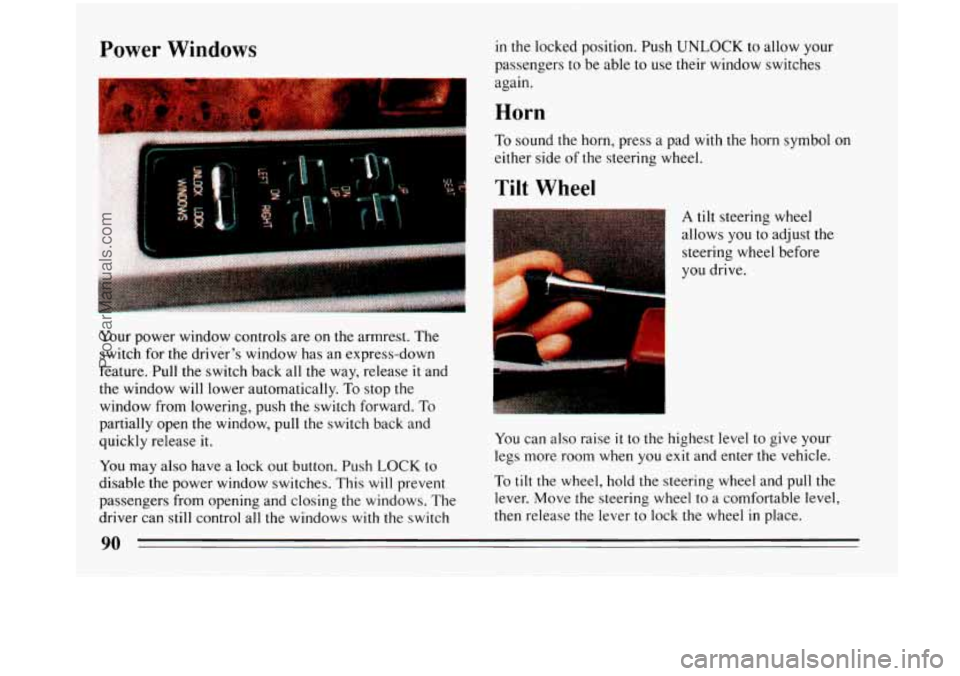
Power Windows
I
Your power window controls are on the armrest. The
switch for the driver’s window has an express-down
feature. Pull the switch back all
the way, release it and
the window will lower automatically.
To stop the
window from lowering, push the switch forward.
To
partially open the window, pull the switch back and
quickly release it.
You may
also have a lock out button. Push LOCK to
disable the power window switches. This will prevent
passengers
from opening and closing the windows. The
driver can still control all the windows
with the switch
in the locked position. Push UNLOCK to allow your
passengers to be able to use their window switches
again.
Horn
To sound the horn, press a pad with the horn symbol on
either side
of the steering wheel.
Tilt Wheel
i
I
A tilt steering wheel
allows you to adjust the
steering wheel before
you drive.
You can also raise it to the highest level to give your
legs more room when
you exit and enter the vehicle.
To
tilt the wheel, hold the steering wheel and pull the
lever. Move the steering wheel to
a comfortable level,
then release the lever to lock
the wheel in place.
ProCarManuals.com